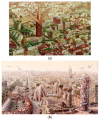Has Biomimicry in Architecture Arrived in France? Diversity of Challenges and Opportunities for a Paradigm Shift
- PMID: 36546912
- PMCID: PMC9775457
- DOI: 10.3390/biomimetics7040212
Has Biomimicry in Architecture Arrived in France? Diversity of Challenges and Opportunities for a Paradigm Shift
Abstract
Biomimicry is a growing field of developing environmental innovations for materials, facade systems, buildings, and urban planning. In France, we observe an extensive diversity of initiatives in biomimicry for the development of regenerative cities. These initiatives blossom in a large range of areas, from education to urban policies, to achieve a major environmental, social and economic paradigm shift. To provide a comprehensive understanding of this development at the national scale, this paper presents and discusses the diversity of the developed initiatives over the last 10 years in six main fields-education, urban policies, fundamental and applied research, design demonstrators, arts, and communication. This research is an opportunistic study based on the analysis of these initiatives enriched by the feedback of the stakeholders collected by the authors working in the field of biomimicry over the last seven years. We identify that biomimicry in France has mainly extended through individual initiatives of teachers, territorial authorities, architectural studios, or researchers rather than through the support of public policies. Putting into perspective developments in biomimicry by other countries, this cross-discipline analysis provides recommendations for the extensive development of regenerative architecture and urbanism at the national scale.
Keywords: France; architecture; arts; biomimicry; demonstrators; education; paradigm shift; public policies; research; urban design; urbanism.
Conflict of interest statement
The authors declare no conflict of interest. The funders had no role in the design of the study, in the collection, analysis, or interpretation of data, or in the writing of the manuscript.
Figures




References
-
- Benyus J.M. Biomimicry: Innovation Inspired by Nature. Harper Perennial; New York, NY, USA: 2002.
-
- Biomimetics—Terminology, Concepts and Methodology. Volume 2015. International Organization for Standardization; Geneva, Switzerland: 2015. [(accessed on 11 October 2022)]. Available online: https://www.iso.org/obp/ui/#!iso:std:62500:en.
-
- Uchiyama Y., Blanco E., Kohsaka R. Application of biomimetics to architectural and urban design: A review across scales. Sustainability. 2020;12:9813. doi: 10.3390/su12239813. - DOI
-
- Zari M.P. Regenerative Urban Design an Ecosystem Biomimicry. Taylor Francis; London, UK: 2018.
-
- Blanco E., Pedersen Zari M., Raskin K., Clergeau P. Urban Ecosystem-Level Biomimicry and Regenerative Design: Linking Ecosystem Functioning and Urban Built Environments. Sustainability. 2021;13:404.
LinkOut - more resources
Full Text Sources

